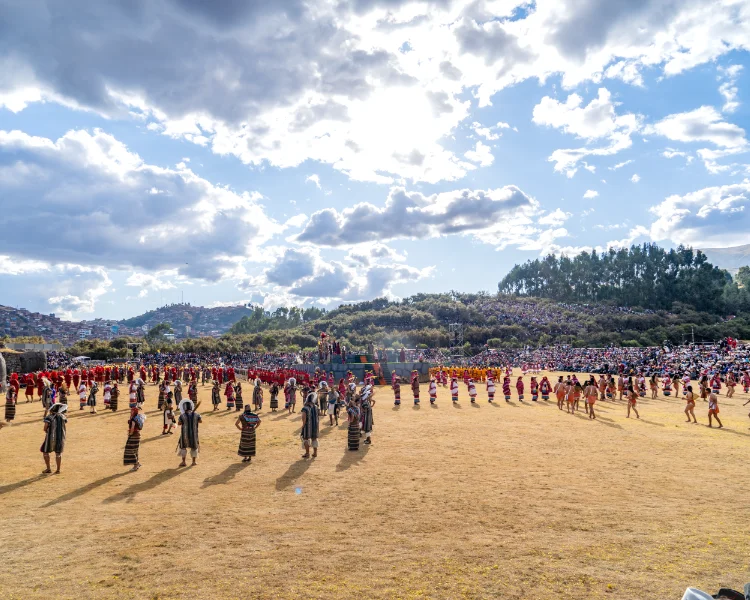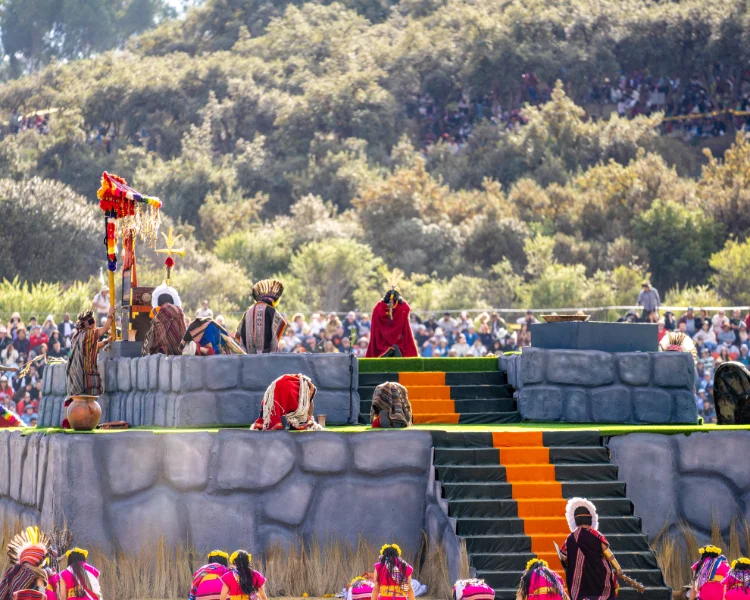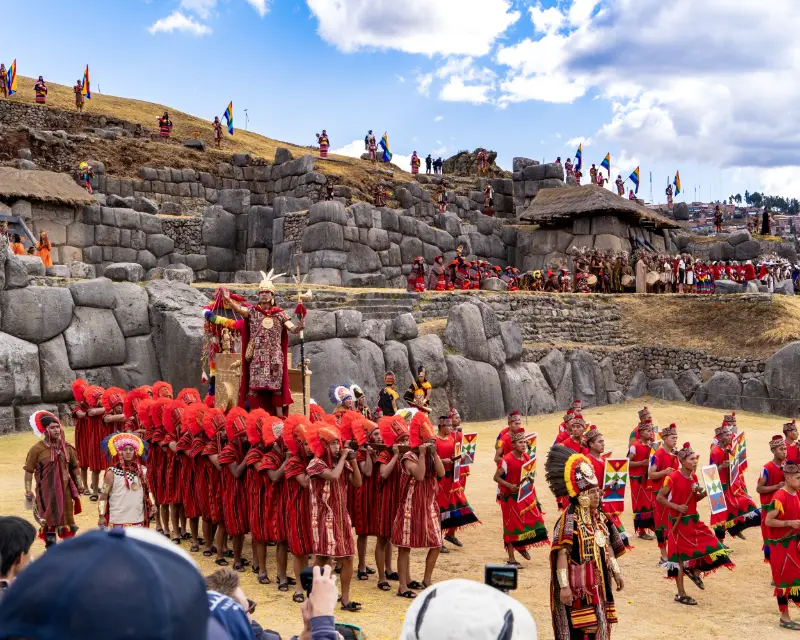Symbolism and spirituality in the Inti Raymi in Cusco
Inti Raymi is an ancestral celebration that honors the sun god, source of light and life in the Incan worldview. This festivity transforms Cusco into a vibrant stage of traditions, where each ritual and offering reflects the sacred connection between humanity and nature. It is a unique experience that fuses history, spirituality and color, inviting you to discover the ancient legacy of a people that vibrates in tune with the universe.
Content:
What is Inti Raymi?

Inti Raymi is a traditional ceremony originating in the Inca Empire, dedicated to Inti, the sun god, considered the main source of life. Originally celebrated during the winter solstice (around June 24), this rite marked the beginning of a new agricultural cycle, in which the forces of the earth were renewed and blessings were requested for the future. Inti Raymi entrance fees.
In pre-Hispanic times, the festival brought together the entire Inca community, in which the Inca, considered the son of the sun, officiated rituals of gratitude and petition for prosperity. With the arrival of the colonial era, many of the practices were transformed or suppressed, however, over time, the tradition was recovered and adapted, becoming an important symbol of Andean identity.
Today, Inti Raymi is celebrated in Cusco, where a theatrical performance recreating the original ceremony is held. This cultural manifestation not only honors the ancestral legacy, but also educates locals and visitors about the Incan worldview, allowing their spirituality and knowledge to remain alive.
The Inti Raymi route
Experience Inti Raymi on a journey full of history and mysticism. The ceremony begins at the Coricancha, the ancient Temple of the Sun, where the first ritual in honor of Inti is performed. Then, the procession advances to the Plaza de Armas, the heart of Cusco, where the Inca and his entourage revive ancient traditions before the eyes of hundreds of spectators. Finally, the celebration culminates in the majestic fortress of Sacsayhuamán, where the main ceremony comes to life among dances, songs and offerings in an imposing natural setting. Don’t miss this unique experience and secure your place by purchasing your tickets at entradaintiraymi.com
Main symbols in the Inca worldview
The Inca worldview is full of symbols that express the intimate connection between humans, nature and the divine. These symbols, carefully integrated into each ritual, reflect a vision of the world in which all elements, from the sun, the earth, fire and the cycles of nature, are interconnected, allowing the community to live in harmony with the environment and respect the natural balance.
-
The Sun (Inti)
It is the center of life and the supreme deity in Inca culture. The sun not only provides light and heat, but is also considered the protector and origin of all life. The figure of the Inca, as a representative of the Sun, reaffirms the legitimacy of his authority and his link with the divine.
-
The Moon (Mama Quilla)
Complementary to solar energy, the moon symbolizes balance, femininity and fertility. In Inca culture, the duality between the sun and the moon expresses the harmony necessary for the proper functioning of the universe.
-
Pachamama (Mother Earth)
It represents the earth as a living and sacred entity, a source of food and sustenance. Rituals in honor of Pachamama seek to guarantee the fertility of the earth and ecological balance, reminding the community of the importance of caring for the natural environment.
-
The fire
Emblematic of transformation and purification, fire symbolizes rebirth and renewal. In the context of Inti Raymi, the sacred flame represents the continuity of the solar cycle and the hope for a new beginning.
-
Offerings (Coca leaves and chicha de jora)
Both elements have an important ritual role. Coca, considered sacred, is used to establish a connection with the divine and obtain visions, while chicha de jora, a fermented corn-based drink, symbolizes abundance and vitality, being a means to share and celebrate life.
The spirituality of Inti Raymi

The spiritual dimension of Inti Raymi goes beyond historical recreation. During the ceremony, every gesture, every offering and every word has a profound meaning, which seems to transcend time and connect the participants with the mystical.
The spirituality of Inti Raymi is intensely experienced in the atmosphere generated during the festival. Music, dance, and the narration of ancient myths contribute to creating a sacred space where the community comes together to celebrate its cultural identity. Each ritual aims to strengthen the ties between individuals and with the earth, reminding them of the importance of living in harmony with everything around us.
This spiritual connection is not only a tribute to the Sun God, but also a form of introspection and personal renewal. In the act of participating in the Inti Raymi, people find a space to meditate on the meaning of life, interdependence with the environment, and the responsibility to preserve the traditions that have shaped our identity.
The Sun as the principle of life
The sun is undoubtedly the most revered element in Inca culture. Considered the primordial source of their vitality, its influence extends to all aspects of existence. Inti, the sun god, is also seen as the reason behind growth, fertility and renewal.
The celebration of Inti Raymi on the winter solstice marks the moment when the sun begins to regain its strength after the shortest period of daylight of the year. This rebirth symbolizes the cycle of life: the death and resurrection of nature, the return of vitality to the earth and the hope of a new harvest.
During the ceremony, the image of the Inca raising his arms towards the sky is an act full of symbolism. This gesture represents direct communion with the sun and reaffirms the belief that Inti’s energy flows through all beings, maintaining order and balance in the universe. Thus, the sun becomes an indicator of the interconnection between humans and nature, with the reminder that we are all part of the same thing.
Some recommendations
To fully enjoy this ancestral experience, we invite you to prepare yourself with a curious and open attitude. Arrive early to absorb every detail, wear comfortable clothing to explore the emblematic corners of Cusco and don’t forget to hydrate well and bring some snacks. Allow yourself to immerse yourself in the vibrant energy of each ritual, letting tradition surprise and envelop you. Come and be part of this unique encounter between past and present, and reserve your place with us to live an unforgettable adventure!
